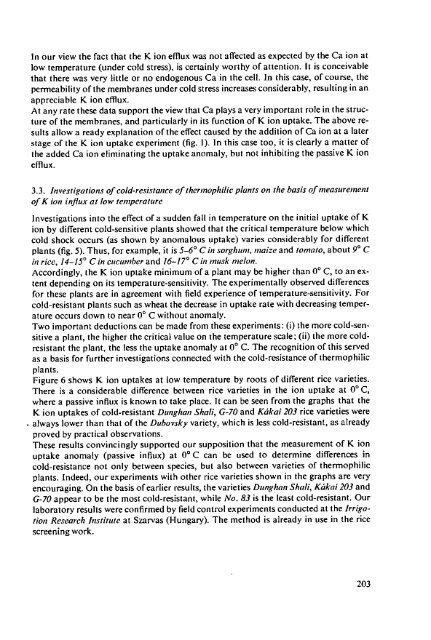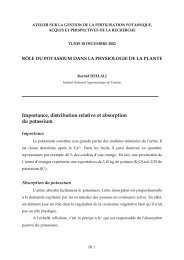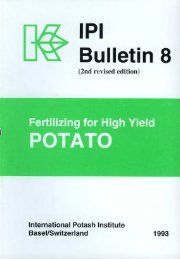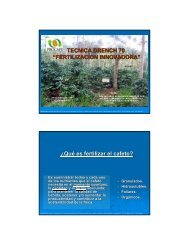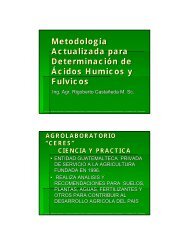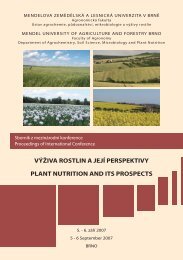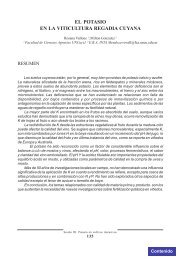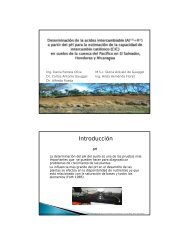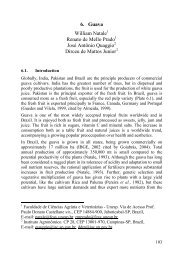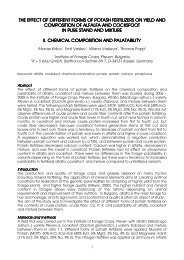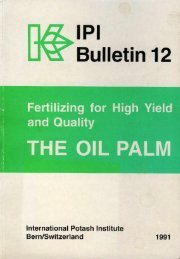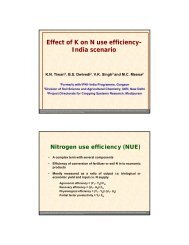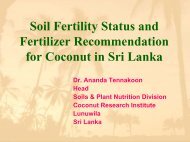Potassium Research and Agricultural Production - The International ...
Potassium Research and Agricultural Production - The International ...
Potassium Research and Agricultural Production - The International ...
You also want an ePaper? Increase the reach of your titles
YUMPU automatically turns print PDFs into web optimized ePapers that Google loves.
In our view the fact that the K ion efflux was not affected as expected by the Ca ion at<br />
low temperature (under cold stress), is certainly worthy of attention. It is conceivable<br />
that there was very little or no endogenous Ca in the cell. In this case, of course, the<br />
permeability of the membranes under cold stress increases considerably, resulting in an<br />
appreciable K ion efflux.<br />
At any rate these data support the view that Ca plays a very important role in the structure<br />
of the membranes, <strong>and</strong> particularly in its function of K ion uptake. <strong>The</strong> above results<br />
allow a ready explanation of the effect caused by the addition of Ca ion at a later<br />
stage of the K ion uptake experiment (fig. I). In this case too, it is clearly a matter of<br />
the added Ca ion eliminating the uptake anomaly, but not inhibiting the passive K ion<br />
efflux.<br />
3.3. Investigations of cold-resistance of thermophilic plants on the basis of measurement<br />
of K iOIl influx at low temperature<br />
Investigations into the effect of a sudden fall in temperature on the initial uptake of K<br />
ion by different cold-sensitive plants showed that the critical temperature below which<br />
cold shock occurs (as shown by anomalous uptake) varies considerably for different<br />
plants (fig. 5). Thus, for example, it is 5-6° C in sorghum, maize <strong>and</strong> tomato, about 9° C<br />
in rice, /4_15° C ill cllcumber <strong>and</strong> 16_17° C i/1 musk melon.<br />
Accordingly, the K ion uptake minimum of a plant may be higher than 0° C, to an extent<br />
depending on its temperature-sensitivity. <strong>The</strong> experimentally observed differences<br />
for these plants are in agreement with field experience of temperature-sensitivity. For<br />
cold-resistant plants such as wheat the decrease in uptake rate with decreasing temperature<br />
occurs down to near 0° C without anomaly.<br />
Two important deductions can be made from these experiments: (i) the more cold-sensitive<br />
a plant, the higher the critical value on the temperature scale; (ii) the more coldresistant<br />
the plant, the less the uptake anomaly at 0° C. <strong>The</strong> recognition of this served<br />
as a basis for further investigations connected with the cold-resistance of thermophilic<br />
plants.<br />
Figure 6 shows K ion uptakes at low temperature by roots of different rice varieties.<br />
<strong>The</strong>re is a considerable difference between rice varieties in the ion uptake at 0° C,<br />
where a passive influx is known to take place. It can be seen from the graphs that the<br />
K ion uptakes of cold-resistant Dunghan Shali, G-70 <strong>and</strong> Ktikai 203 rice varieties were<br />
. always lower than that of the Dubovsky variety, which is less cold-resistant, as already<br />
proved by practical observations.<br />
<strong>The</strong>se results convincingly supported our supposition that the measurement of K ion<br />
uptake anomaly (passive influx) at 0° C can be used to determine differences in<br />
cold-resistance not only between species, but also between varieties of thermophilic<br />
plants. Indeed, our experiments with other rice varieties shown in the graphs are very<br />
encouraging. On the basis of earlier results, the varieties Dunghan Shali, Ktikai 203 <strong>and</strong><br />
G-70 appear to be the most cold-resistant, while No. 83 is the least cold-resistant. Our<br />
laboratory results were confirmed by field control experiments conducted at the Irrigatioll<br />
<strong>Research</strong> Institule at Szarvas (Hungary). <strong>The</strong> method is already in use in the rice<br />
screening work.<br />
203


